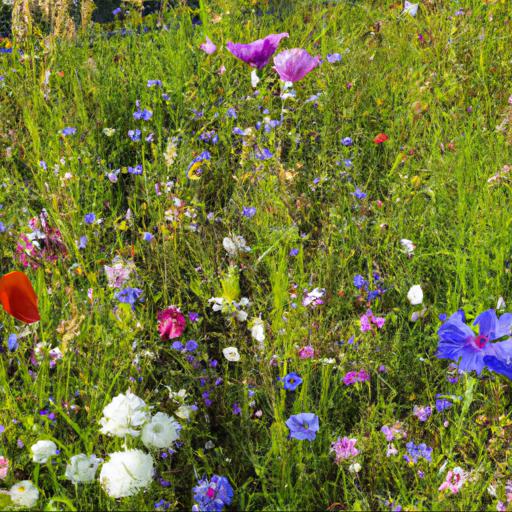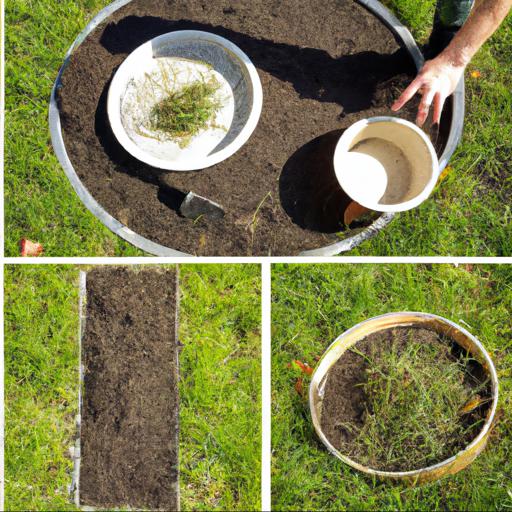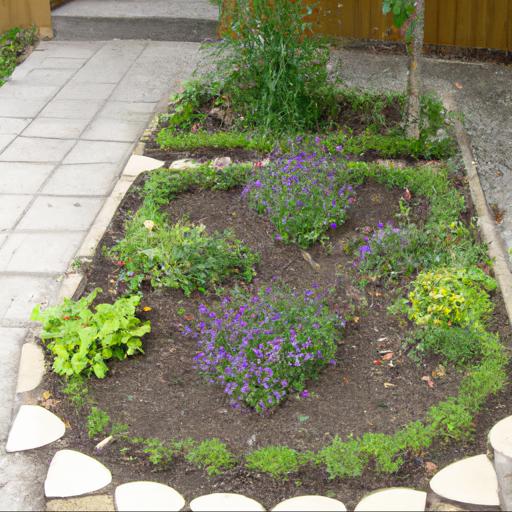Are you looking for a way to add some color and life to your outdoor space? Creating a mini-meadow is a great way to do just that!
In this blog, we’ll explore three ways to create a mini-meadow in your backyard or garden. From selecting the right plants to choosing the perfect location, we’ll cover all the essential steps for creating a beautiful, vibrant mini-meadow. So, if you’re ready to bring some life to your outdoor space, let’s get started!
Benefits of creating a mini-meadow

Creating a mini-meadow in your garden is an excellent way to bring greater biodiversity to your outdoor space. Mini-meadows can help you attract and support native wildlife, and also provide a beautiful and eco-friendly way to turn your outdoor area into a haven of colour and flourishing nature.
Here are three simple ways to create a mini-meadow of your own. First, start by selecting some native wildflowers for your mini-meadow. Many people opt for the ‘meadow mix’ variety of wildflowers, which contains a range of colourful species perfect for attracting bees, butterflies, and other pollinators to your garden.
Additionally, choosing native flowers specifically adapted to your climate and soil type will make it much easier to manage and maintain your mini-meadow in the long run. Secondly, to ensure that your mini-meadow is attractive and full of life, it’s important to prepare the soil properly before planting.
Many gardeners opt for no-dig methods, such as layering compost, leaf mould and other organic matter over the area, to improve soil fertility and add fertility to the ground. As well as improving the soil’s ability to hold moisture and nutrients, this incorporation of organic matter helps to encourage the growth of beneficial microorganisms, creating an ideal environment in which native wildflowers can thrive. Finally, to keep your mini-meadow in top condition throughout the year, regular maintenance is essential.
This includes removing any dead or invasive plants as soon as possible, as well as cutting down tall grasses in autumn in order to make room for new growth. Additionally, hand-weeding the mini-meadow is a great way to tackle any emerging weeds before they take over.
Creating a mini-meadow is an easy, enjoyable way to bring more biodiversity and colour to your garden, while also providing a secure habitat for local wildlife. With a little planning and preparation, you can soon have your own mini-meadow oasis in which bees, butterflies, birds and other creatures can come together and flourish.
Three steps to create a mini-meadow

Creating a mini-meadow in your garden is a great way to add a vibrant splash of color, attract wildlife and even help the environment. To ensure a successful mini-meadow, it’s important to prepare the area and choose the right plants.
This blog post explores three key steps to creating a stunning mini-meadow in your garden. Firstly, you need to prepare the area before sowing your mini-meadow, as this will help to create the best conditions for the wildflowers to grow and flourish. Clear the area of debris such as leaves and twigs, and remove any existing weeds.
The soil should then be loosened to create a good environment for rooting. The ideal mini-meadow soil is light and sandy, however, even if your soil is heavy clay you can still create a successful mini-meadow. To do so, you should include lightening additives such as grit, compost, manure and leaf-mould to the soil.
The second step to creating a mini-meadow is selecting the right wildflower species for the area. In order to ensure a beautiful and sustainable mini-meadow for years to come, the selection of species must be carefully thought-out.
Ensure that the flowers you choose are appropriate for the soil type and sun aspect. Varieties such as poppies, cornflowers and daisies are all great choices for a five-star mini-meadow.
Also, if you want to attract wildlife to your garden, bee-friendly wildflowers are always a great option. The third step is to sow the mini-meadow. To ensure the best possible results, this stage should be carried out in late autumn or early spring.
Measure out the area you are looking to sow and spread the wildflower seed mixture evenly. Be aware that some flowers may take up to two years to flower, so make sure to be patient. When the mini-meadow is sown you can finish off by adding a cover of grit or sand. This helps to protect the seeds from winds, birds, and the cold winter weather. Once you have followed these steps and watered your meadow, you can sit back and watch your mini-meadow burst into life. Enjoy the beautiful range of colour and variety of wildlife that follows, knowing that it was you who created this stunning garden feature.
Tips for maintaining a mini-meadow

Creating a mini-meadow in your garden can be a great undertaking. It involves preparing the ground, selecting plants that suit the soil and climate, and crafting an attractive outdoor space. To help you achieve a successful result, we’ve put together three tips for maintaining a mini-meadow.
To start, cultivate soil that is rich with organic matter and possesses good drainage capabilities; the plants will require nutrients to grow and should be kept moist but not inundated with too much water. Then, select hardy species that can thrive in your area and are appropriate for the size of your garden, considering warmth and light levels.
To ensure that your meadow is aesthetically pleasing, try to plant complementary varieties. This could include annuals, which will bloom from spring to late summer, to provide year round interest.
Once the plants are in place, mulching is an important addition to a mini-meadow. Not only is it a natural way to provide a steady supply of nutrients throughout the season but it will also help to create the right balance between the soil and the contaminants that often linger on the surface. Mulching also helps to protect plants from extreme heat and cold, as well as helping to retain soil moisture.
Finally, regular maintenance is essential for a mini-meadow, as plants may very quickly become overgrown. Make sure to keep up with the pruning by cutting off dead blooms and discarding diseased leaves; this will encourage healthy growth each season. There may even be a need to de-weed and top-dress the meadow a couple of times a year in order to sustain optimum conditions.
By following these three tips, you’ll be able to achieve a lush, thriving mini-meadow in your garden. With the right content and care, this paradise of blooms and foliage will provide a beautiful backdrop to your summer days and be a source of pride.
Conclusion
Creating a mini-meadow can be a great way to make your outdoor space more beautiful and inviting. There are three main ways to do this: planting wildflower seeds, using native plants, and adding in a few shrubs and trees.
With a bit of planning and effort, you can create a stunning mini-meadow that will attract wildlife and enhance your outdoor area.
FAQ
What plants are best suited for a mini-meadow?
Some of the best plants for a mini-meadow are wildflowers, grasses, and low-growing shrubs. These plants will provide a variety of colors and textures, and will help to attract beneficial insects and wildlife to the area.
How much space is needed for a mini-meadow?
The amount of space needed for a mini-meadow will depend on the size and type of plants you are growing. Generally, a mini-meadow should be at least 10 square feet in size.
What are the benefits of having a mini-meadow?
The benefits of having a mini-meadow include providing a habitat for wildlife, increasing biodiversity, improving air quality, reducing soil erosion, and providing a beautiful and natural landscape.
How often should a mini-meadow be maintained?
A mini-meadow should be maintained at least once a year, preferably in the spring or fall. Additionally, it should be monitored throughout the growing season to ensure that it is healthy and free of weeds.
What type of soil is best for a mini-meadow?
The best type of soil for a mini-meadow is a well-draining, nutrient-rich soil with a slightly acidic pH.
What are some tips for creating a successful mini-meadow?
1. Choose a sunny spot with well-drained soil. 2. Select native plants that are adapted to your local climate and soil conditions. 3. Plant in groups of three or more of the same species for a more natural look. 4. Plant in layers, with taller plants in the back and shorter plants in the front. 5. Add a layer of mulch to help retain moisture and keep weeds at bay. 6. Water regularly during the first few months to help the plants establish. 7. Allow the plants to self-seed to help keep the meadow looking full and healthy.

